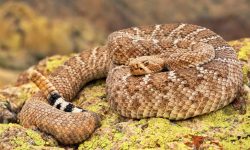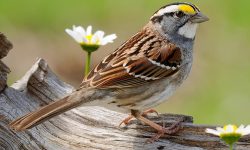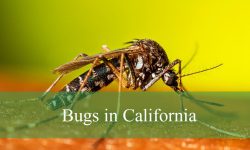Most types of butterfly caterpillars are colorful and worm-like crawling creatures. They come in different shapes, colors, and sizes. Identifying the exact name of a butterfly caterpillar can be a daunting experience.
This caterpillar identification guide shares the description and pictures of different butterfly larvae. The pictures of caterpillars that turn into butterflies will help you them with ease.
Are Butterfly Caterpillars Poisonous?
Butterfly caterpillars are non-poisonous and harmless. But some caterpillar species that feed on milkweed plants can be poisonous to birds and other small predators.
Do not handle butterfly caterpillars with sharp-looking spines without protective gloves to avoid the painful sting. (Source: USA Today News)
Brightly colored caterpillars with sharp spines and hairs are venomous. When the spines break into the skin, you will experience severe itching and nasty rashes.
Different Types of Butterfly Caterpillars
Identifying caterpillars that turn into butterflies can be a daunting experience. Here is a list of 15 types of butterfly caterpillars with their description and pictures:
Common Buckeye Butterfly Caterpillar
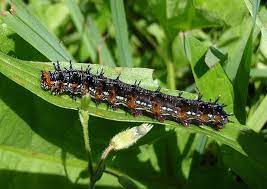
It is a dark brown caterpillar with two distinctive faint stripes along the back and tufts of short spines. The spiked caterpillar also has reddish-orange and white spots.
The bulbous orange head is the distinctive feature for easy identification. This black spiky caterpillar turns into an attractive buckeye butterfly after pupation.
The brown wings on the butterflies have six conspicuous eyespots and orange markings for beautification. The larvae feed on the weed plantain in spring before pupation.
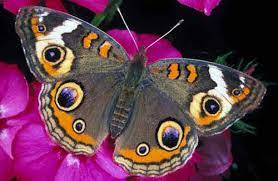
Scientific Name |
Junonia coenia |
Host Plants |
Weed plantain |
Identification Features |
Dark brown body with faint stripes along its abdomen and tufts of short spines. |
American Painted Lady Butterfly Caterpillar
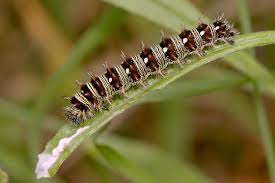
It is a spiny brown caterpillar with yellow bands traversing its abdomen. The red and creamy-yellow dots wrapping each segment are the distinctive feature.
The spotted brown and yellow caterpillar has thin black spines that cause a painful sting and severe skin irritation. These larvae feed on the foliage of asters and ironweeds.
The crawling insect turns into a vibrant orange and brown butterfly after pupation. The wings have prominent eyespots on the underside.
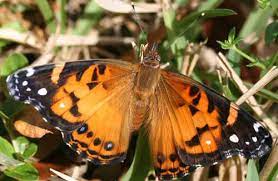
Scientific Name |
Vanessa virginiensis |
Host Plants |
Asters, sunflowers, and ironweed plants |
Identification Features |
Yellow-banded brown body covered in jaggy spines and bright red and creamy-white dots. |
Pearl Crescent Butterfly Caterpillar
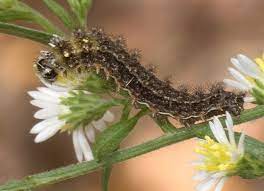
It is a strange-looking spiky brown caterpillar covered in white dots and tufts of short spines. The larva raises its front when threatened as a defense mechanism.
The dark-brown larva turns into a spectacular brown and orange pearl crescent butterfly after pupation. The conspicuous black markings on the wings create intricate patterns.
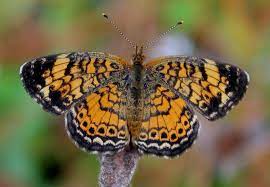
Scientific Name |
Phyciodes tharos |
Host Plants |
Asters |
Identification Features |
Spiny brown caterpillar with a black head and several faint white dots |
Peacock Butterfly Caterpillar
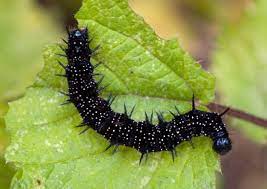
It is a long slender black caterpillar covered in several white spots and black spikes for easy identification. The fleshy spines are harmless and do not sting when handled.
The shiny black larva turns into a rusty red-winged flying insect after pupation. Each wing has a conspicuous blue and red eyespot on the top corner.
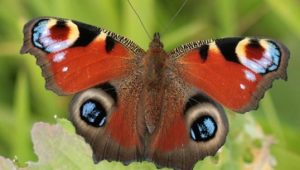
Scientific Name |
Aglais io |
Host Plants |
Stinging nettle plants |
Identification Features |
Spiky black caterpillar with numerous white spots. |
White Admiral Butterfly Caterpillar
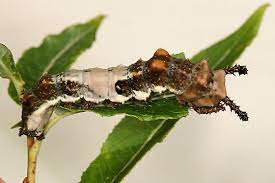
It is a butterfly larva that resembles bird poop on a tree branch. These crawling creatures have olive-green or brown-and-white bodies that create a jaggy appearance.
The white blotches and unevenly shaped bodies make it easier for them to hide from potential predators. They turn into butterflies with jet-black wings with white bands.
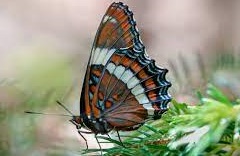
Scientific Name |
Limenitis arthemis |
Host Plants |
Willow, aspen, birch, and poplar trees. |
Identification Features |
Strange-looking olive-green or brown-and-white caterpillar. |
Zebra Longwing Butterfly Caterpillar
![]()
It is a grayish-green caterpillar covered in long black spines. The black dots on the grayish-green body are distinctive features.
The crawling insect moves around on spiny black legs and often feeds on passionflower plants. They turn into zebra-like butterflies after pupation.
![]()
Scientific Name |
Heliconius charithonia |
Host Plants |
Passionflower plants |
Identification Features |
Spiky grayish-green caterpillar with several black dots and brown underside. |
Queen Butterfly Caterpillar
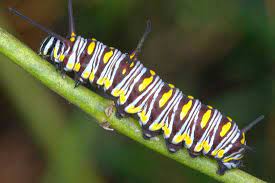
It is a black and white striped caterpillar having yellow dots on the black bands. The plump caterpillar has six fleshy tentacles and feeds on milkweed plants.
The caterpillar turns into a rusty-brown or orange butterfly with white dots on the wings after pupation. The black bands along the margins are distinctive features.
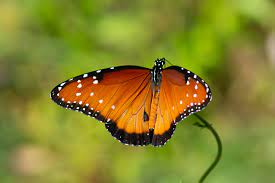
Scientific Name |
Danaus gilippus |
Host Plants |
Milkweed plants |
Identification Features |
Black and white bands with yellow dots on the black bands |
Monarch Butterfly Caterpillar
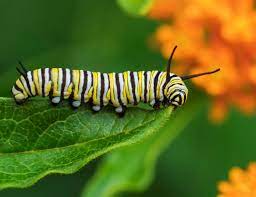
It is a striped butterfly caterpillar with bands of black, yellow, and white. The long fleshy horns and two stumpy appendages are the distinctive features.
Monarch caterpillars are poisonous to birds and other small predators. They obtain their toxic substances from milkweed plants.
These crawling insects turn into iconic bright orange-winged butterflies with back-veins markings. The stripy appearance makes it easier to identify and classify them.
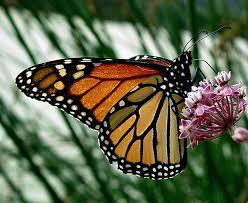
Scientific Name |
Danaus plexippus |
Host Plants |
Milkweed plants. |
Identification Features |
Bands of white, black, and yellow |
Mourning Cloak Butterfly Caterpillar
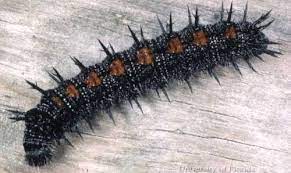
The butterfly larva is also called a spiny elm caterpillar. The spiky crawling insect has a black body with orange-red dots on its back.
The sharp-looking spikes cause skin irritation and nasty rashes when handled without wearing protective gloves.
These caterpillars turn into dark chocolate-brown flying insects after pupation. The wings have golden yellow margins and bands of blue dots.
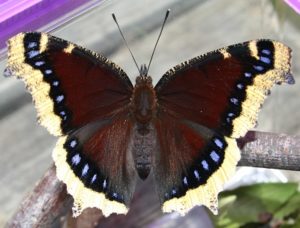
Scientific Name |
Nymphalis antiopa |
Host Plants |
Willow, elm, poplar, hackberry, and birch trees |
Identification Features |
Jet black body with dark red dots along the back and black branched spines. |
Gulf Fritillary / Passion Butterfly Caterpillar
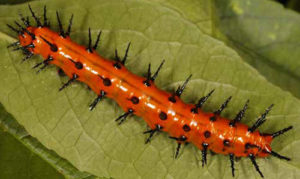
It is a fairly orange and black caterpillar covered in black branched spines. These dark orange caterpillars have slender and cylindrical bodies with six black prolegs.
The two black curved spiny horns on the heads and six small forelegs are the identifiable features. These Florida caterpillars feed on the leaves of passion plants.
These crawling insects turn into butterflies with dark orange bodies and bands of spiny spikes around their segments. The brown wings with white dots are distinctive traits.

Scientific Name |
Agraulis vanillae |
Host Plants |
Passion Flowers |
Identification Features |
The orange and black caterpillar turns into dark orange body butterflies with bands of spiny spikes around its segments. |
Cloudless Sulphur Butterfly Caterpillar
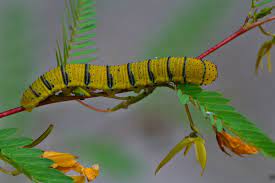
It is a vibrant yellow caterpillar with thin black bands wrapping around its body. The golden yellow larva also has indentations that create a band appearance.
The slug-like caterpillar may appear pale to dark green with a yellow band along the sides and covered in bluish dots.
These caterpillars turn into spectacular yellow insects with pale yellow wings and brown margins. The black stripes across the back and black speckles are the distinctive traits.
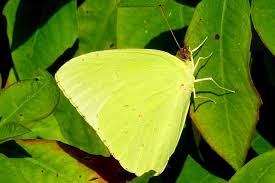
Scientific Name |
Phoebis sennae |
Host Plants |
Peas |
Identification Features |
Yellow larva with thin black bands wrapping around the body. |
Hackberry Emperor Butterfly Caterpillar
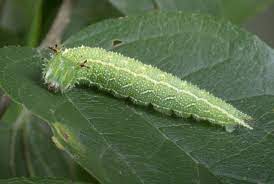
It is a broad pale-green caterpillar with a cylindrical-shaped body and a band of yellow markings along its back. The spiny horns and split tail are other distinctive features.
These crawling creatures turn into eye-catching brown-winged flying insects. These wings vary in color due to different growth phases.
A mature hackberry emperor butterfly has dark-brown and light-brown wings that contain black, white, and yellow spots.
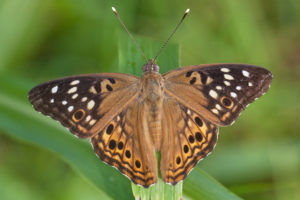
Scientific Name |
Asterocampa celtis |
Host Plants |
Hackberry trees |
Identification Features |
Cylindrical shaped pale green caterpillar with bands of yellow markings along its back. |
Cabbage White Butterfly Caterpillar

It is a slender pale-green caterpillar with pale yellowish dots, a yellow longitudinal line, and fine hairs covering the body.
These fuzzy green caterpillars are also called cabbageworm since they love munching the leaves of cabbages. After pupation, they turn into cabbage white butterflies.
These butterflies have creamy-white wings with small black or brown dots. The cabbage butterflies also have black bodies with two slender clubbed antennae.
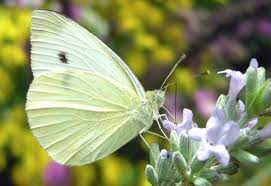
Scientific Name |
Pieris rapae |
Host Plants |
Cabbages and kales |
Identification Features |
Worm-like pale green larva with fine hairs covering its body. |
Eastern Tiger Swallowtail Butterfly Caterpillar
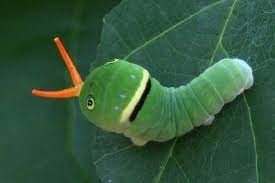
The strange-looking caterpillar has a dull green body with conspicuous eyespots on its head. The stumpy green caterpillar has a large head and grows up to 55mm long.
A juvenile species has brown and white colors, while the mature counterpart switches colors from green to brown before pupation.
The foul smell emission and forked tongue are the defensive features against potential predators. The bird poop appearance on tree branches also helps hide from predators.
These Texas caterpillars turn into pretty yellow butterflies with black markings around their wings. These butterflies are often seen in summer and fall.
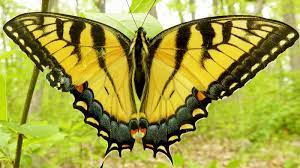
Scientific Name |
Papilio glaucus |
Host Plants |
Sweet bay magnolia and tulip tree |
Identification Features |
Dark green caterpillar with faint bands on its segment and eyespots on the head |
Black Swallowtail Butterfly Caterpillar
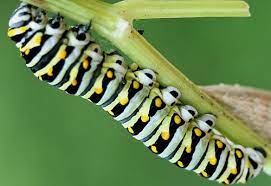
It is a large plump lime-green caterpillar with black and yellow bands wrapping around each segment. The larva colors keep changing due to different growth phases.
A juvenile black swallowtail caterpillar is spiky brown with a wide white saddle band around the middle segment. These caterpillars can grow up to 50mm long.
These bright green striped caterpillars turn into vibrant black swallowtail butterflies after pupation. The fly insect has yellow, white, and blue markings on its wings.
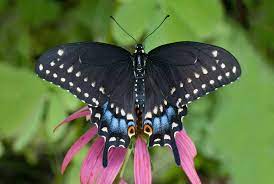
Scientific Name |
Papilio polyxenes |
Host Plants |
Hemlock, parsnip, and wild carrots |
Identification Features |
Bright green caterpillar with black and yellow bands around each segment. |
Related Articles:


